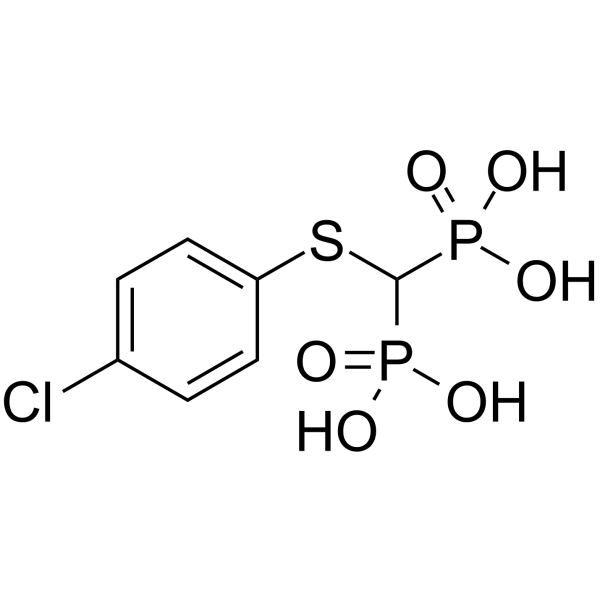89987-06-4
| Name | [(4-chlorophenyl)sulfanyl-phosphonomethyl]phosphonic acid |
|---|---|
| Synonyms |
Acide tiludronique
Acido tiludronico Acidum tiludronicum [INN-Latin] Tiludronate Tiludronic Acid Acido tiludronico [INN-Spanish] Acide tiludronique [INN-French] Acidum tiludronicum UNII-6PNS59HP4Y |
| Description | Tiludronate (Tiludronic Acid), an orally active bisphosphonate, can act an osteoregulator. Tiludronate is used for the research of the metabolic bone disorders. Tiludronate is a potent inhibitor of the osteoclast vacuolar H(+)-ATPase. Antiresorptive and anti-inflammatory properties[1][2][3][4]. |
|---|---|
| Related Catalog | |
| In Vitro | The ability of Tiludronate to inhibit proton transport is 5-fold higher in kidney-derived vesicles (IC50=1.1 mM) and 10,000-fold higher in vesicles derived from osteoclasts (IC50=466 nM). Tiludronate also potently inhibited proton transport in yeast microsomal preparations (IC50=3.5 microM) and inhibited the activity of purified yeast V-ATPase. The inhibition of the osteoclast V-ATPase-mediated proton transport by Tiludronate is rapid, pH-dependent, and reversible[3]. |
| In Vivo | Tiludronate exerts a dose-dependent inhibitory activity on bone resorption. Tiludronate could act on mature osteoclasts by reducing their capacity to secrete proton into the resorption space and also by favoring their detachment from the bone matrix. Tiludronate is also tested in other models of osteoporosis. In the castrated male rat model, Tiludronate (5-200 mg/kg; p.o.) prevents the decrease in the skeletal mass, assessed physically by measuring the bone weight and density or chemically by determining the calcium and phosphate content[3]. |
| References |
[3]. Bonjour JP, et al. Tiludronate: bone pharmacology and safety. Bone. 1995;17(5 Suppl):473S-477S. |
| Density | 1.82g/cm3 |
|---|---|
| Boiling Point | 600.7ºC at 760 mmHg |
| Molecular Formula | C7H9ClO6P2S |
| Molecular Weight | 318.61 |
| Flash Point | 317.1ºC |
| Exact Mass | 317.92800 |
| PSA | 159.98000 |
| LogP | 2.07110 |
| Index of Refraction | 1.652 |
